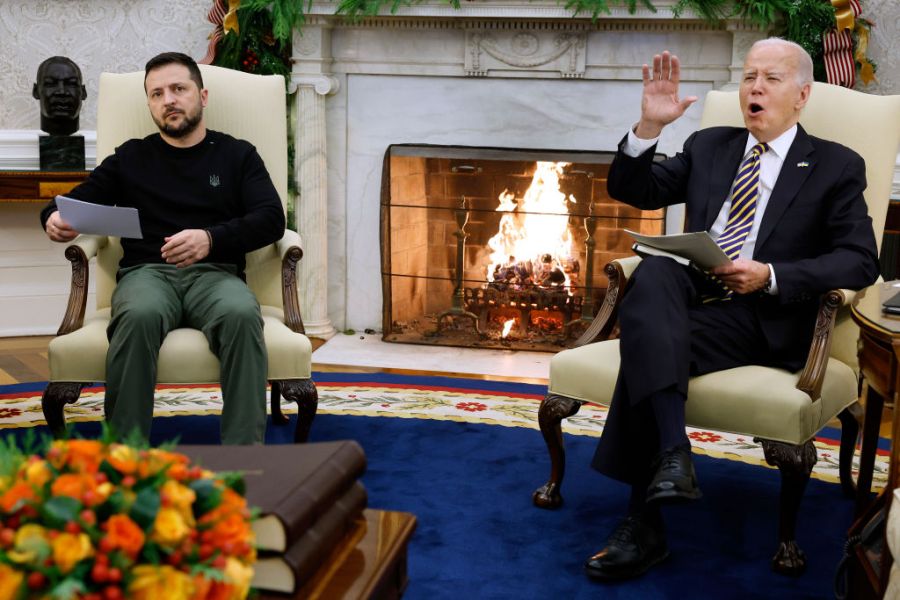
As members of Congress return from their recent hiatus, aid for Ukraine remains stalled. For six months, Republicans and Democrats in the House have debated a foreign supplemental aid package that would provide greater assistance to this Eastern European state.
When the new bill was proposed in October 2023, Republicans in both chambers of Congress stated that Ukraine, as well as Israel and Taiwan, could not receive aid from the United States unless Congress also discussed border security reform. Several months later, Republicans decided they would not pursue border reforms after all. The Senate eventually passed the foreign supplemental aid package with overwhelming bipartisan support in February 2024, but the legislation remains stuck in the House.
Now, many Democrats and the Senate have called on Speaker of the House Mike Johnson (R-La.) to bring Ukraine aid to a vote. They state that the House bill on Ukraine should be the one that the Senate passed. Others have proposed a loan program for Ukraine, where the Ukrainian government would eventually repay the U.S. government. Finally, a small portion of hard-right Republican members of the House have opposed Ukraine aid altogether. This group is doing everything it can to ensure that Speaker Johnson will not bring a vote on Ukraine aid to the House floor for a vote.
As House members continue to delay this aid bill, thousands of Ukrainians have died at the hands of Russia’s brutal invasion. Stalled assistance to the Eastern European state has allowed Russian forces to bolster their defenses and prepare for new attacks. The Ukrainians are running out of ammunition. Recent reports state that the Russian Federation is preparing for a new offensive.
The war will only worsen if the House continues to delay its aid.
In addition, the Russian Federation’s actions have become even more reckless. Most recently, it launched a drone strike against the Zaporizhzhia Nuclear Power Plant, the largest nuclear plant in Europe. The attack damaged the facility. If Russia continues these strikes on the installation, the International Atomic Energy Agency concluded that such incidents would “significantly increase the risk of a major nuclear accident.”
In other words, the situation is becoming dire. But as the House continues to deliberate on Ukraine aid, members of Congress could pursue a temporary alternative. The U.S. government should simply use Russian assets instead to rebuild Ukraine.
Currently, the U.S. has frozen Russian assets valued at $60 billion. If the U.S. government were to seize these assets, it would provide a temporary solution to the current Ukraine aid bill stalled in Congress.
The Eastern European state requires immediate infrastructure investments. The funds from seized Russian assets could rebuild Ukrainian bridges, roadways, residential areas, and government buildings.
It is important to stress that seizing Russian assets should not be used as a substitute for the delayed foreign supplemental aid package. Western officials toying with the idea do not want to use these funds for military hardware and equipment. The proposed Ukraine aid bill in the House still needs to be passed to provide the necessary weapons and military equipment to the Ukrainians.
But these efforts would help Ukraine through other means. It would also force reparations upon the Russian government and elites who condone and support the war.
This would not be the first time a perpetrator of a war would be forced to pay for reconstruction efforts. Following the conclusion of the Napoleonic Wars during the early 1800s, the French were forced to pay reparations to rebuild the European continent. Similarly, the Germans were ordered to pay reparations to rebuild Europe at the end of the First World War. Thus, forcing Russia to pay for their invasion of Ukraine would follow an established precedent.
Congress is evaluating the option. In January, the Senate Foreign Relations Committee reviewed the REPO for Ukrainians Act, which would let the president “confiscate and vest in the U.S. government any sovereign assets of Russia or Belarus” and use them to “provide humanitarian and economic assistance to Ukraine.”
The Senate Foreign Relations Committee voted 20 to 1 in favor of the bill. The proposed legislation was then placed on the Senate Legislative Calendar.
The Biden administration has also stated that it would support legislation allowing the U.S. government to use some “frozen Russian assets to help pay for [the] reconstruction of Ukraine.” Finally, the proposal has strong bipartisan support in the House and Senate.
This sort of seizure of assets would in fact be unprecedented. And there are several risks associated with such a policy. Some have argued that it could harm the value of the U.S. dollar by making foreign regimes and businesses wary of conducting business with the U.S.
Second, countries with strained or unfavorable relations with the U.S. could retaliate by freezing American assets. This could stain the dollar’s reputation and hurt U.S. trade relations with other countries worldwide.
Finally, the seizure of Russian assets could become a propaganda tool in Russia’s hands. It could lead to further anti-American sentiment throughout Russia and increase Russian support for the war in Ukraine.
But as the essential and much-needed foreign supplemental aid package stalls in the House, the seizure of Russian assets would provide temporary assistance to the Ukrainians. It would help them get a head start on their reconstruction efforts, which experts predict will take many years and cost more than $1 trillion.
Every contribution toward Ukraine’s reconstruction efforts makes a difference. Using the frozen $60 billion in Russian assets in the U.S. will not end the war, but the U.S. should do everything it can to help the Ukrainian government rebuild during this crucial period in the war. Passing the REPO Act will help with this process.
Mark Temnycky is an accredited freelance journalist covering Eurasian affairs and a nonresident fellow at the Atlantic Council’s Eurasia Center.

